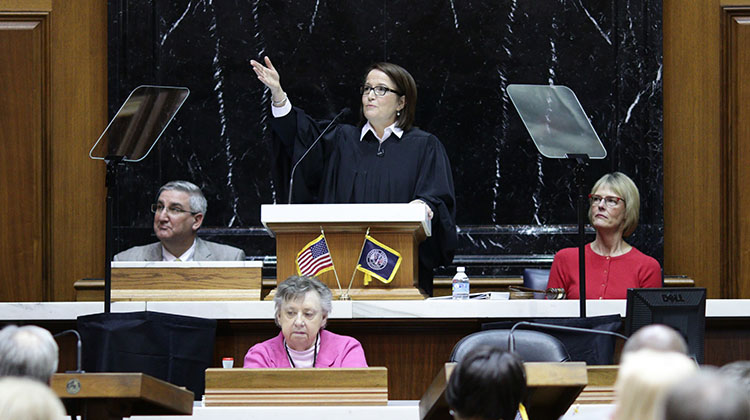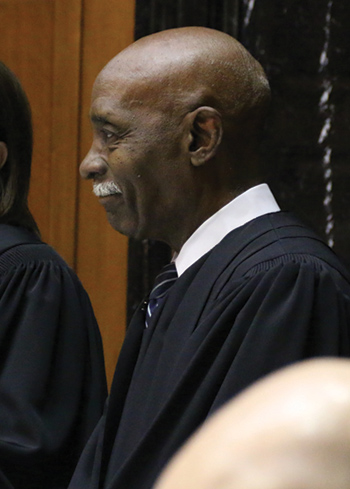
On January 18, 2017, Indiana Chief Justice Loretta Rush delivered her third address on the State of the Judiciary to a joint session of the Indiana General Assembly.
Highlights of the speech follow. We also invite you to read the entire text, watch the video, and view photographs at: courts.in.gov/supreme/2552.htm
The Supreme Court Justices and Judges of the Court of Appeals were greeted by escorts from the House and Senate, including Representatives Cindy Ziemke, Wendy McNamara, Ed DeLaney, Ryan Hatfield and Senators Rodric Bray, Sue Glick, Tim Lanane, and Karen Tallian. Nearly seventy trial court judges, special guests, members of the media, and newly elected officials from all branches of government were present for the joint session of the Indiana General Assembly.
Lt. Gov. Suzanne Crouch called the session to order and invited the Chief Justice to deliver her third address on the “condition of the courts” in Indiana.
Chief Justice Rush began by noting that in 2016 Indiana courts continued to carry out their constitutional mission in the nearly 1.4 million cases brought before them – but they did not accomplish the mission alone. She attributed the success to many “partners in justice”—the focus of her address.
She introduced the Supreme Court’s newest Justice, Geoffrey Slaughter, and noted that he shared the highlight of his appointment with the historic World Series win by his favorite team, the Chicago Cubs.
Honoring Justice Rucker
Rush then turned her attention from the Court’s newest member to its longest serving, Justice Robert D. Rucker. After inviting him to the podium, she spoke highly of the Gary native, who is retiring after 26 years of distinguished judicial service.
While studying at Indiana University Northwest, our nation called Rucker to serve in Vietnam where he was awarded a Purple Heart and a Bronze Star for his heroism.
Returning from service, he graduated from Valparaiso Law School and began his legal career as a deputy prosecutor, then worked as a city attorney and later in private practice. Governor Evan Bayh appointed him to the Court of Appeals in 1991, and Governor Frank O’Bannon named him to the Supreme Court in 1999.
“Rucker’s 1,235 legal opinions stand as a powerful illustration of the guidance courts provide for the peaceful resolution of disputes encompassing nearly every facet of Hoosier life.”
Chief Justice Rush announced that the Court will be returning to Gary Roosevelt High School in March to hear one of Justice Rucker’s final arguments.

Updates
Indiana’s new commercial courts are hearing dozens of complex business litigation cases in the six pilot sites throughout the state; and, the Court completed an exhaustive reorganization of the judicial branch administrative services. She introduced and welcomed former Henry County Circuit Court Judge Mary Willis as the first Chief Administrative Officer of the Supreme Court.
The Chief Justice reaffirmed the commitment to make dedicated Veterans’ Courts available to all qualified service members, noting that six new Veterans’ Courts will join the nineteen already active. Overall, 82 problem-solving courts are addressing substance abuse, mental health, violence, and re-entry issues.
She welcomed and introduced the nine Marion County Small Claims Court judges. They will serve as full-time judicial officers under the Code of Judicial Conduct and will share in existing and developing technology and the judicial education programs.
Partners in Justice
Rush turned her attention to the Hoosier partners in justice. Nineteen special guests from across the state attended the speech, representing clerks, support staff, public defenders, prosecutors, probation officers, volunteers, advocates, law enforcement, interpreters, service providers, mentors, educators, community corrections, child services employees, local government officials, attorneys, and others who help make Indiana’s judiciary more effective.
She then began a state-wide tour highlighting their vital contributions in three major and ongoing judicial branch initiatives:
- Adopting modern technology to revolutionize our court system;
- Ensuring public safety that complements important criminal code reforms; and,
- Supporting and strengthening Hoosier families in need.
Revolutionary Use of Technology
The Chief Justice began by thanking the court’s constitutional partners—the clerks.
Rush thanked Hamilton County Clerk Tammy Baitz and Chief Deputy Debbie LePere for their work on the Court’s electronic filing system, which streamlines the legal process – saving time and money. Indiana’s e-filing initiative began in July 2015 with the goal of improving efficiency and accessibility to our courts. Eighteen months later, the technology is utilized in over 25% of Indiana counties, totaling 30,000 filings each week.
She also praised Tippecanoe County Clerk Christa Coffey and Henry County Clerk Debra Walker, for helping to determine what documents should be made available online. Coffey and Walker are both representatives on the Advisory Task Force on Remote Access to and Privacy of Electronic Court Records.
Criminal Code Reform
Rush noted that law enforcement is one of the judiciary’s vital partners in the implementation of criminal justice reform. She cited Wayne County Judge Darrin Dolehanty, who refers to his local Sheriff Jeff Cappa as a hero in the Juvenile Detention Alternatives Initiative (JDAI) program. The program’s objective is to keep communities safe while reducing childhood incarcerations.
Indiana has 32 JDAI counties with initial reporting showing a 50% reduction in children being incarcerated, along with a corresponding 45% reduction in felony charges. Naturally, these reductions resulted in significant dollar savings to both the individual counties and to the state.
Rush also reported that the Court is reviewing the overall fairness of court procedures that require monetary bail for low-risk offenders who do not exhibit a threat to public safety. Eleven counties—Allen, Bartholomew, Grant, Hamilton, Hendricks, Jefferson, Monroe, Porter, St. Joseph, Starke, and Tipton—have already assembled pilot teams that include prosecutors, public defenders, law enforcement officers, and elected officials.
Probation is under the direction of Indiana’s trial court judges, and increased probation supervision is an important element of criminal justice reform efforts. Rush turned her attention to Miami County Probation Officer Mandy Miller, recognized for her dedication to helping individuals in the probation system.
“Last year 1,300 Indiana probation officers supervised over 129,000 offenders — one officer for every 100 offenders. Indiana’s courts depend on dedicated probation officers.”
Rush noted that courts implementing criminal justice reform require increased utilization of community-based corrections to help offenders succeed. She cited a man in Dubois County, 79-year-old Community Corrections volunteer Bob Vogler, who leads a partnership between local work-release and a faith-based community called Churches Embracing Offenders.
One hundred volunteers from eight churches focus on the spiritual and emotional well-being of the people in the program. He hosts a monthly Wednesday night meal, meets and prays with his clients, and donates his time to making their lives better.
Strengthening Hoosier Families
Rush noted that last year there were over 14,000 cases where a person appeared in court with limited to no English proficiency, or was deaf or hearing impaired. Marion County Prosecutor Terry Curry recognized this problem and appointed Deputy Prosecutor Lun Pieper as the Burmese Outreach Director for his office and calls her “an invaluable asset in working with our Burmese population.”
“As an immigrant who once lived under a military dictatorship where there are no jury trials or plea agreements, Lun brings more than bilingual skills to the courtroom: she understands her clients’ day-to-day challenges and works with families on Victim Impact Panels and crime prevention.”
Chief Justice Rush recognized South Bend attorney Mark Torma for his work helping families, specifically those who are trying to navigate the court system without the aid of an attorney. He recently helped a family avoid a housing crisis by resolving a $200 monthly utility bill dispute.
This past year, the Indiana Supreme Court created a Coalition for Court Access to find solutions to pressing needs like these everyday disputes. Rush thanked Mark, the Coalition, and the 7,200 attorneys who donated more than 220,000 volunteer hours to Hoosiers in need last year.
Rush noted that Indiana judges last year succeeded in changing the lives of almost 4,000 Hoosier children by issuing adoption decrees, giving these children a stable “forever family.” Adoption Day is celebrated across the state with community partners like the Great Kids Make Great Communities program in Allen County. Judge Charles Pratt depends on Family Court Administrator Nancy Springer to coordinate their Adoption Day festivities.
Rush stated that last year alone, almost 18,000 children entered the child welfare system, resulting in a 23% increase in Child in Need of Services (CHINS) cases.
“These are cases of abuse and neglect, where a child’s parent has been dealing meth, or is in jail for battery, or—with frightening frequency—where an innocent baby is brought into the world addicted to drugs. The courts could not help these children without dedicated partners.”
Rush recognized Tippecanoe County Prosecutor Pat Harrington, who is partnering with the faith community and establishing a residential shelter to help children in his community who have been sexually trafficked.
The Chief Justice also praised the 3,400 Court Appointed Special Advocates (CASAs), who serve as front-line advocates for thousands of children who need a voice in court. Judge Stephen Galvin of Monroe County turned to CASA Gary Friedman to be that “voice” for an 8-year-old girl named Kadi. She began life in need of a liver transplant and with birth parents who could not care for her. Thanks to Gary and Kadi’s adoptive parents, Mark and Donna Kingsbury, she now focuses on important 8-year-old matters like swimming and drawing.
Rush noted that while those judicial partners help children, others help Hoosiers later in life. She showcased Owen County’s Volunteer Guardianship Program, one of 29 across our state, which serves vulnerable seniors. Judge Lori Quillen knows this program is crucial to preserving the well-being of seniors in need, like an elderly neglected woman named Sue. Family members were stealing money and medications from her.
Rush then recognized Heather Donovan, Sue’s court-appointed Guardian, who ensured that her final days on this earth were spent in the safety of her home, complete with assisted care, occupational therapy, and delivered meals.
Chief Justice Rush concluded by stating that those recognized during the address are just a small sample of the work done by many partners working for justice. Rush also recognized one final partner — the dedicated members of Indiana’s Executive and Legislative branches.
“Your partnerships on these many initiatives illustrate your commitment to our State, your dedication to serving our citizens, and most of all your deep desire to ensure the future is bright for all Hoosiers. Thank you and God bless our State.”